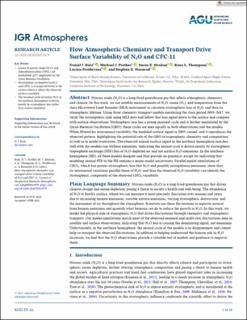| dc.description.abstract | Nitrous oxide (N2O) is a long-lived greenhouse gas that affects atmospheric chemistry and climate. In this work, we use satellite measurements of N2O, ozone (O3), and temperature from the Aura Microwave Limb Sounder (MLS) instrument to calculate stratospheric loss of N2O, and thus its atmospheric lifetime. Using three chemistry transport models simulating the Aura period 2005–2017, we verify the stratospheric sink using MLS data and follow that loss signal down to the surface and compare with surface observations. Stratospheric loss has a strong seasonal cycle and is further modulated by the Quasi-Biennial Oscillation (QBO); these cycles are seen equally in both observations and the models. When filtered for interannual variability, the modeled surface signal is QBO-caused, and it reproduces the observed pattern, highlighting the potential role of the QBO in tropospheric chemistry and composition, as well as in model evaluation. The observed annual surface signal in the northern hemisphere matches well with the models run without emissions, indicating the annual cycle is driven mostly by stratosphere-troposphere exchange (STE) flux of N2O-depleted air and not surface N2O emissions. In the southern hemisphere (SH), all three models disagree and thus provide no guidance, except for indicating that modeling annual STE in the SH remains a major model uncertainty. Parallel model simulations of CFCl3, which has greater stratospheric loss that N2O and possibly surreptitious emissions, show that its interannual variations parallel those of N2O, and thus the observed N2O variability can identify the stratospheric component of the observed CFCl3 variability. | en_US |
